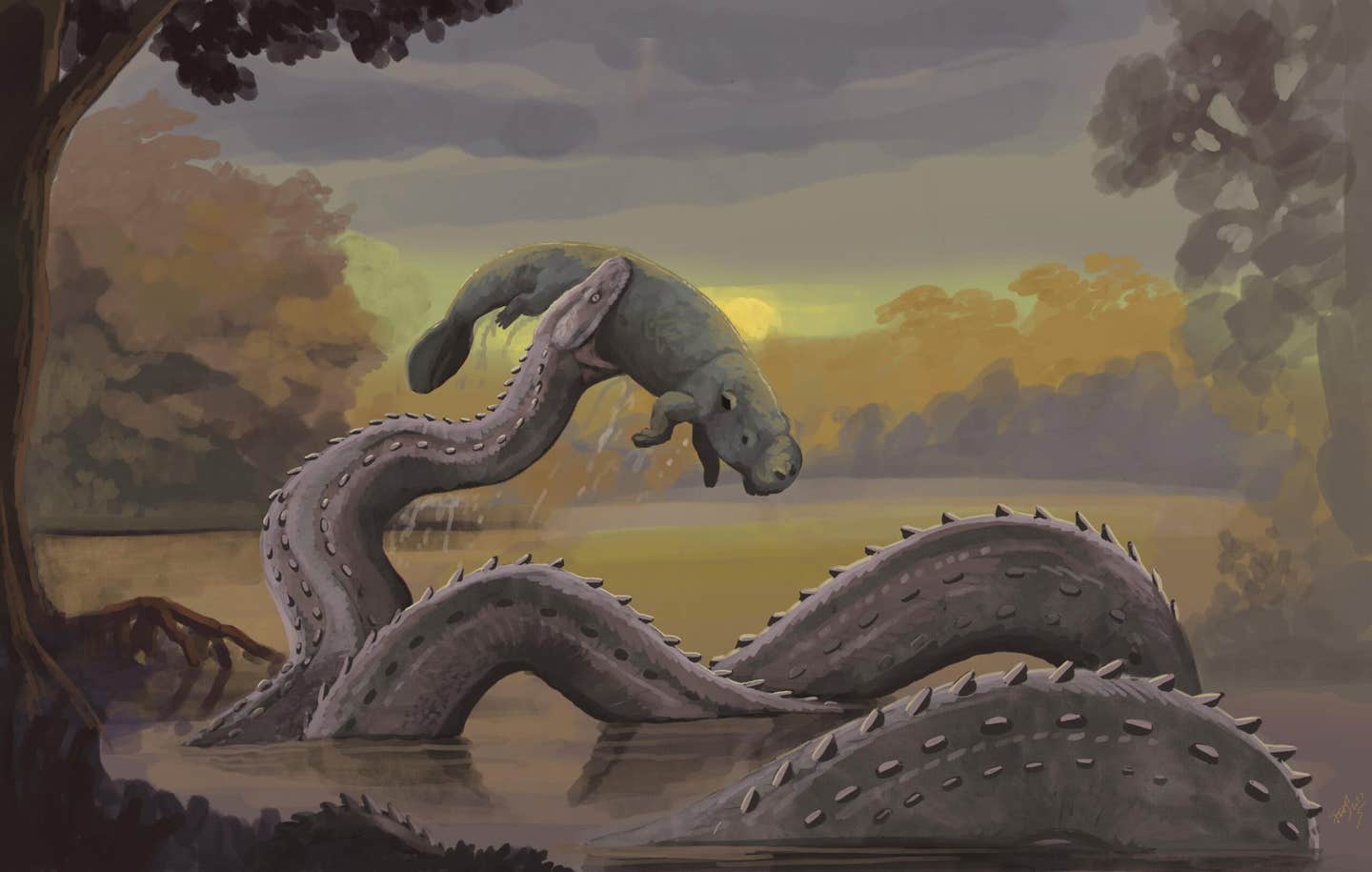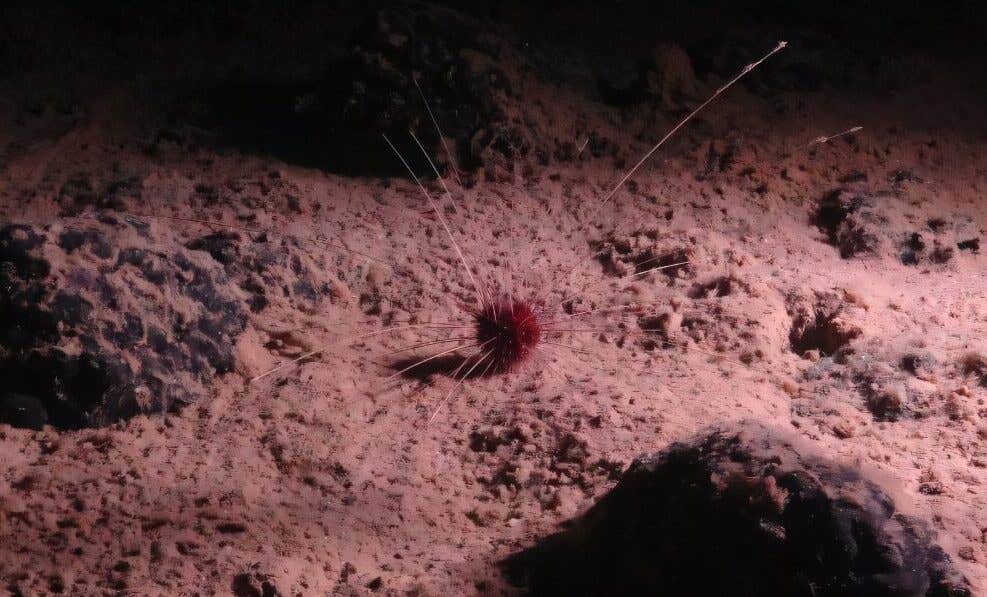Scientists discover colossal 50-foot long snake from 47 million years ago
Researchers uncover a 50-foot fossil snake in India, revealing a massive predator that reshapes the history of snake evolution.

The fossil of Vasuki indicus, a 50-foot prehistoric snake found in India, reveals one of the largest serpents ever to roam Earth. (CREDIT: @HodariNundu)
In the arid shale beds of western India, scientists have uncovered a remarkable fossil that tells the story of a prehistoric snake that once ruled the landscape. Named Vasuki indicus, this massive serpent stretched an estimated 50 feet long and likely weighed over 2,200 pounds. The discovery ranks it among the largest snakes ever found, rivaling the infamous Titanoboa and revealing new details about ancient ecosystems and snake evolution.
The fossil was found in the Panandhro Lignite Mine of Gujarat’s Kutch region, embedded in a grey shale layer dating back around 47 million years to the Middle Eocene. Researchers from the Indian Institute of Technology Roorkee led the excavation, retrieving 27 fossilized vertebrae from what was once a fully grown snake. The exceptional preservation of the bones allowed scientists to analyze the creature’s size, shape, and lifestyle in extraordinary detail.
A Colossal Predator With Mythical Roots
The name Vasuki indicus reflects both its size and cultural significance. It honors Vāsuki, the divine serpent of Hindu mythology known for coiling around Lord Shiva’s neck. This nod to Indian folklore highlights the deep symbolic link between snakes and regional traditions while honoring a creature that was truly gigantic in life.
Scientists describe Vasuki as having a thick, cylindrical body and a wide vertebral structure. Its massive build likely made it a slow mover. Instead of chasing prey, it probably lay in wait for unsuspecting animals, similar to how modern pythons use ambush tactics. Once it struck, the snake would have relied on powerful constriction to overpower its victims.
Due to its size and weight, it was likely limited to short bursts of movement. This suggests Vasuki didn’t rely on speed but instead depended on surprise and brute strength to capture its prey. Researchers believe it lived in a warm, tropical forest environment that could support large-bodied animals, indicating rich biodiversity during that time.
A Glimpse Into Prehistoric Ecosystems
The fossilized remains of Vasuki indicus not only offer a closer look at the snake itself but also open a window into the world it lived in. The region during the Middle Eocene experienced warm climates, which may have helped reptiles grow to enormous sizes. This tropical setting likely featured lush vegetation and a wide variety of prey species.
Related Stories
- Titanoboa: The massive 45-foot snake that ruled the prehistoric world
- Man injected by 856 snake bites helps create universal antivenom
- AI develops life-saving snake venom treatment - helping two million people per year
Lead researcher Professor Sunil Bajpai and postdoctoral fellow Debajit Datta stressed the importance of the find. They believe it sheds light on India’s paleontological richness and adds new understanding of how ancient snakes evolved and adapted. The fossil supports the idea that certain snake lineages were more widespread and diverse than previously thought.
The vertebrae came from a member of the Madtsoiidae family—an extinct group of land-dwelling snakes. These snakes roamed across Gondwana, the ancient supercontinent that included what is now South America, Africa, India, Australia, and Antarctica.
Madtsoiids are known for their large size and primitive body structure, but most are known only from isolated vertebrae. This has made their evolutionary history difficult to piece together.
In India, Madtsoiids date back as far as the Late Cretaceous. Fossils of similar snakes have been found in the Deccan volcanic region and the Cambay Shale in western India. Notable relatives include Madtsoia pisdurensis and Platyspondylophis, but Vasuki indicus stands out due to its sheer size and completeness.
Expanding the Family Tree
The Madtsoiidae family spanned about 100 million years, appearing during the Late Cretaceous and disappearing in the Late Pleistocene. Their range once stretched from Madagascar to Europe, with later forms restricted to areas like India, North Africa, and Australia. These snakes likely thrived in tropical environments where high temperatures may have supported the growth of large-bodied reptiles.
Despite the wide distribution of Madtsoiids, their placement on the snake evolutionary tree remains debated. Some studies include them within the group of true snakes (Serpentes), while others position them just outside it. These disagreements have made it harder to understand their migration patterns and evolutionary radiation.
The discovery of Vasuki indicus during a particularly warm period of Earth’s history adds to the theory that higher temperatures may have supported the growth of massive reptiles.
According to the team, this find provides important data that could help map how large snakes evolved in different parts of the world. It also supports the idea of intercontinental dispersal across Gondwanan landmasses.
A Legacy Carved in Stone
The Kutch fossil is not just a remarkable scientific discovery—it is a milestone in understanding the prehistoric biodiversity of the Indian subcontinent. With each new fossil find, researchers piece together more of Earth’s evolutionary past, and Vasuki indicus offers a dramatic chapter in that story.
The Indian subcontinent continues to prove itself as a key region for paleontological research. The fossil’s well-preserved state has allowed scientists to infer behavior, body structure, and ecological role. It challenges assumptions about snake evolution and shows that giant serpents weren’t limited to South America or Africa but also thrived in ancient India.
As more fossils are unearthed, the mystery of how these massive reptiles lived, hunted, and moved across continents may slowly unfold. For now, Vasuki indicus stands as one of the largest and most impressive snakes ever found, a powerful symbol of both ancient life and scientific discovery.
The longest snakes in the world today
Reticulated Python (Malayopython reticulatus)
The reticulated python is the longest snake in the world, reaching lengths of up to 30 feet (9 meters). Native to Southeast Asia, it thrives in rainforests, grasslands, and woodlands. Its striking pattern of dark and light bands gives it the name "reticulated." This non-venomous constrictor preys on mammals and birds, and while there are rare reports of attacks on humans, these pythons typically avoid contact.
Green Anaconda (Eunectes murinus)
While the green anaconda holds the title of the heaviest snake, it can still grow up to 29 feet (8.8 meters) long. Found in South America, particularly in the Amazon and Orinoco basins, this massive snake is semiaquatic, spending much of its time in swamps and rivers. Its bulky frame allows it to overpower large prey like capybaras, deer, and even caimans through constriction.
Burmese Python (Python bivittatus)
This large python can grow up to 23 feet (7 meters) long and is native to Southeast Asia. It inhabits marshes, grasslands, and open forests. Known for being an invasive species in the Florida Everglades, the Burmese python has a voracious appetite, feeding on birds, mammals, and even alligators. Its popularity in the pet trade has contributed to its spread outside of its native range.
African Rock Python (Python sebae)
Africa's largest snake, the African rock python, can reach lengths of up to 20 feet (6 meters). It is found across sub-Saharan Africa and can live in a variety of habitats, including savannas, forests, and grasslands. Known for its aggressive nature when threatened, this constrictor preys on large animals such as antelopes and warthogs.
Indian Python (Python molurus)
Closely related to the Burmese python, the Indian python can grow up to 20 feet (6 meters) long. It inhabits the forests, grasslands, and swamps of the Indian subcontinent. This species is revered in Indian culture, often depicted in folklore. It is a powerful constrictor, preying on small mammals, birds, and reptiles.
Amethystine Python (Morelia amethistina)
Also known as the scrub python, the amethystine python can grow up to 19 feet (5.8 meters) and is native to Australia, Papua New Guinea, and parts of Indonesia. It is named for its iridescent scales that shimmer with a purple hue in the light. This python is an excellent climber and hunter, preying on birds, bats, and small mammals.
King Cobra (Ophiophagus hannah)
The king cobra is the longest venomous snake in the world, capable of reaching lengths of up to 18 feet (5.5 meters). Native to Southeast Asia and parts of India, this snake is known for its potent neurotoxic venom and characteristic hood. Despite its intimidating size, it primarily feeds on other snakes, including venomous species.
Boa Constrictor (Boa constrictor)
The boa constrictor can grow up to 13 feet (4 meters) long and is native to tropical regions of Central and South America. While not as long as some pythons, it is an iconic constrictor species that uses its muscular body to subdue prey. Boas are solitary hunters and have been known to live in a variety of habitats, from rainforests to arid regions.
Yellow Anaconda (Eunectes notaeus)
Though smaller than its relative, the green anaconda, the yellow anaconda can still grow up to 13 feet (4 meters) long. It is found in the swamps and marshlands of South America, particularly in Paraguay and Argentina. Like other anacondas, it is semiaquatic and preys on aquatic animals, such as fish and birds.
Olive Python (Liasis olivaceus)
The olive python, native to Australia, can reach lengths of up to 13 feet (4 meters). It gets its name from its smooth, olive-colored scales. This python prefers rocky outcrops and gorges, where it can find prey like wallabies, bats, and small mammals. It is non-venomous and constricts its prey to kill it.
These snakes represent the most impressive lengths in the world of reptiles, showcasing a diversity of habitats, behaviors, and adaptations for survival.
Research findings are available online in the journal Scientific Reports.
Note: Materials provided above by The Brighter Side of News. Content may be edited for style and length.
Like these kind of feel good stories? Get The Brighter Side of News' newsletter.



